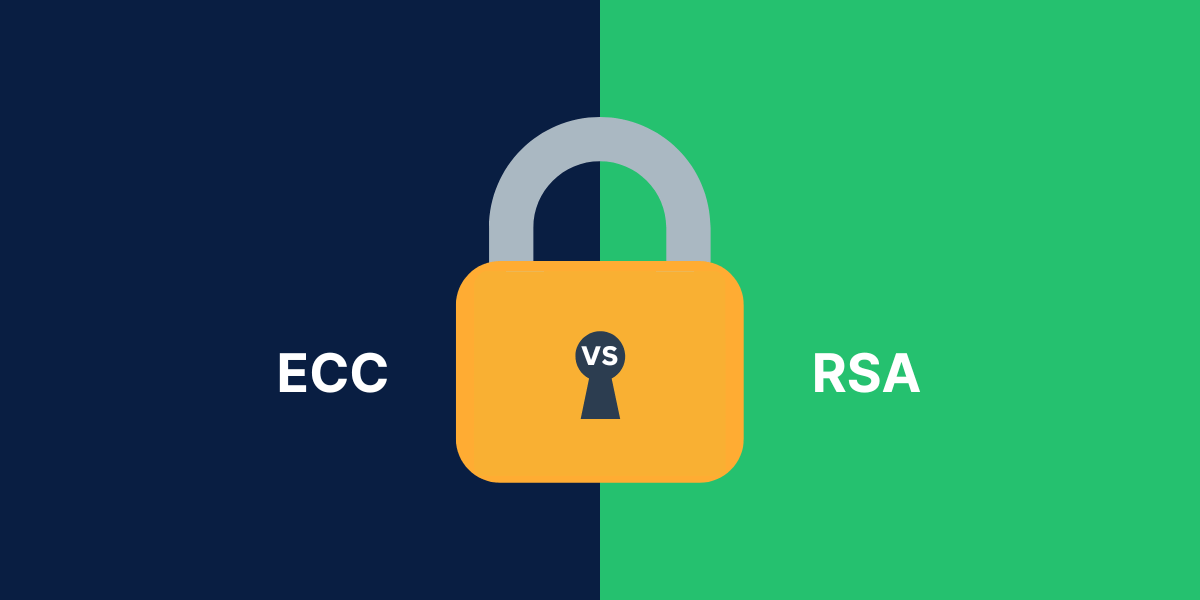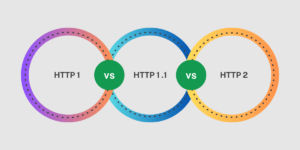What’s the Difference Between ECC and RSA
Public key cryptography plays a crucial role in securing communications over the Internet. Two of the most commonly used public key algorithms for SSL/TLS encryption are Elliptic Curve Cryptography (ECC) and RSA. The ECC vs RSA debate is an important consideration for many organizations and individuals. Both algorithms have advantages and disadvantages in terms of performance and security.
This article provides a comprehensive comparison of ECC vs. RSA, analyzing the differences in key size, speed, security, and use cases. We will also examine the history and workings of both algorithms. By the end, you will have a clear understanding of which algorithm may be better suited for your specific needs.
Key Takeaways
- ECC offers equivalent security to RSA but with smaller key sizes, resulting in improved performance.
- RSA encryption/decryption is slower compared to ECC due to the mathematical operations involved.
- The ECC recommended key size is 256 bits versus 2048 bits for RSA for comparable protection. This allows ECC certificates to be faster and take up less bandwidth.
- Both ECC and RSA are considered secure against brute force attacks if implemented correctly with sufficient key lengths.
- ECC is better suited for devices with low computing power, such as mobiles and IoT devices. RSA is preferred for applications requiring backward compatibility like web servers.
- Major web browsers and servers support both RSA and ECC TLS certificates. ECC adoption has steadily increased in recent years.
ECC vs RSA: A Quick Comparison
| Feature | ECC | RSA |
| Mathematical basis | Elliptic curve discrete logarithm problem | Integer factorization of large primes |
| Typical key sizes | 224, 256, 384, 521 bits | 2048, 3072, 7680 bits |
| Equivalent security | ECC-256 = RSA-3072 | RSA-2048 = ECC-224 |
| Speed | Faster key gen & operations | Slower than ECC |
| Power efficiency | More efficient | Less efficient |
| Memory usage | Lower | Higher |
| Quantum resilience | More resilient | Vulnerable to quantum attacks |
| Implementation risks | Side channel attacks | Weak key generation |
| Adoption | Growing steadily | Universal adoption currently |
| Protocols supported | TLS, IPsec, DNSSEC, etc. | All major protocols |
| Use cases | Constrained devices, TLS servers | CAs, archival docs, backward compatibility |
| Standards | NIST, Suite B | Widely used even without standards |
What is Public Key Cryptography?
Public key cryptography, also known as asymmetric cryptography, uses a pair of keys – a public key and a private key – to encrypt and decrypt data. The public key is made openly available, while the private key is kept secret.
Some common uses of public key cryptography include:
- Encryption: Data encrypted with the public key can only be decrypted with the corresponding private key. This allows secure data transmission.
- Authentication: Digital signatures created with the private key can be verified with the public key, which is used to confirm identity and authenticity.
- Key Exchange: Public key cryptography is used in protocols like Diffie-Hellman key exchange to securely establish shared keys over an insecure channel.
Basic Overview of ECC
Elliptic Curve Cryptography (ECC) is based on algebraic structures called elliptic curves over finite fields. Neil Koblitz and Victor Miller introduced it independently in 1985.
Some properties of elliptic curves are leveraged to create the public and private key pairs. The private key is a random integer, while the public key is a point on the curve derived from the private key.
Basic Overview of RSA
Described in 1977, Rivest–Shamir–Adleman (RSA) got its name from three MIT professors: Ron Rivest, Adi Shamir, and Leonard Adleman- who publicly described it.
It uses the mathematical properties of prime factorization. The public and private keys are generated from two large prime numbers multiplied together. Factoring the product of two large primes is considered computationally infeasible.
Now, let’s analyze ECC and RSA across various parameters.
Key Size Relationship and Examples of ECC and RSA
Due to the different mathematical bases, RSA and ECC offer various levels of security for the same key sizes. A much smaller ECC key is needed to achieve the same security level as a larger RSA key.
Some equivalent key size examples between ECC and RSA are:
- A 256-bit ECC key offers approximately the same security as a 3072-bit RSA key.
- A 384-bit ECC key is comparable to a 7680-bit RSA key.
- A 521-bit ECC key is equivalent to a 15360-bit RSA key.
This means ECC can achieve very high levels of security with small and efficient keys. Generating and working with such large RSA keys is computationally infeasible.
The recommended minimum key size for RSA is 2048 bits. For ECC, NIST recommends minimum key sizes of 224 bits for low-security and 256 bits for high-security applications.
Following are rough equivalent key sizes for symmetric encryption algorithms vs RSA and ECC:
- 80-bit symmetric key = 1024-bit RSA = 160-bit ECC
- 112-bit symmetric key = 2048-bit RSA = 224-bit ECC
- 128-bit symmetric key = 3072-bit RSA = 256-bit ECC
- 192-bit symmetric key = 7680-bit RSA = 384-bit ECC
- 256-bit symmetric key = 15360-bit RSA = 521-bit ECC
As can be seen, ECC can match the security level of large RSA keys with that of much smaller keys. This makes ECC computationally more efficient and better suited for constrained devices.
Security Comparison Between RSA and ECC
Both RSA and ECC have been studied extensively by mathematicians and security researchers and are considered secure if properly implemented and sufficiently large key sizes are used.
However, some differences exist in the types of cryptographic attacks they are vulnerable to:
RSA Security
- RSA keys are vulnerable to brute-force attacks if their size is too small. This can be mitigated by using sufficiently large key sizes, at least 2048 bits and higher, for stronger security.
- The security of RSA depends on the difficulty of factoring large prime numbers. There are no known efficient algorithms to factor very large numbers.
- Integer factorization for RSA keys is considered infeasible, up to 15360 bits with current computing capabilities, though theoretical attacks exist.
- Quantum computers pose a major threat to RSA as they can efficiently factor large numbers using Shor’s algorithm.
ECC Security
- Like RSA, small ECC key sizes can be brute forced. Using 256-bit or larger keys mitigates this threat.
- The best-known mathematical attacks against ECC are the Pollard rho and Pohlig-Hellman algorithms, which are very complex.
- ECC is not vulnerable to quantum algorithms like Shor’s, which break RSA. However, it is susceptible to quantum algorithms like Grover’s search, which reduces its security strength somewhat.
- Physical side-channel attacks on smartcards and hardware security modules are a concern that needs to be addressed in ECC software implementations.
- ECC randomness and parameter generation must be done carefully to avoid backdoors and intentional weaknesses.
Thus, both RSA and ECC offer adequate security if properly implemented at sufficiently high key lengths matching security needs. ECC has some advantages against quantum algorithms, but side-channel attack risks need mitigation.
Performance Comparison Between ECC and RSA
Due to the smaller key sizes at the same security level, ECC outperforms RSA on computation time, power efficiency, and memory usage, particularly on constrained devices.
Speed
- Encryption and decryption operations with ECC keys are much faster than those with RSA keys. Cloudflare’s benchmarking showed ECC-256 to be 20-116 times faster than RSA-3072 for TLS handshakes.
- Even on powerful servers, ECC improves TLS handshake performance and reduces load compared to RSA. This enables better scalability for high-traffic secure web servers.
- Due to faster computations, the speed advantages of ECC are even more pronounced for resource-constrained devices like mobiles and IoT.
Memory Usage
- Smaller ECC key sizes substantially reduce the memory needed to store keys as compared to equivalently strong RSA keys.
- This allows efficient implementation on memory-restricted devices like embedded systems and IoT. Storing RSA keys requires a lot more memory.
- A 256-bit ECC public key requires just 32 bytes, compared to 384 bytes for a 3072-bit RSA key. At higher security levels, the RSA key size balloons tremendously.
Power Efficiency
- The efficiency benefits of ECC also translate into lower power consumption, which is important for battery-powered devices like mobiles and IoT.
- RSA computation at higher security levels drains device batteries much faster than ECC algorithms designed specifically for low-power devices like IoT.
Thus, ECC provides significant performance benefits over RSA when implemented on constrained environments like mobiles, browsers, IoT devices, etc., where speed, memory usage, and power matter.
Support and Adoption: ECC vs RSA
While ECC adoption is increasing steadily, RSA still enjoys wider support across different protocols, applications, and platforms. However, ECC support is expanding rapidly.
RSA Support
- RSA is supported across all major protocols, such as TLS, S/MIME, PGP, SSH, IPsec, IKE, etc. Clients and servers also universally endorse it.
- Almost all public key cryptography libraries, including OpenSSL, Java, Microsoft CAPI, and .NET, implement the RSA algorithm.
- RSA is natively supported across web servers, databases, appliances, enterprise applications, and other platforms. It can be used widely without external libraries.
- All major browsers have long-supported RSA keys for TLS. Modern browsers now also support ECC alongside RSA.
ECC Support
- ECC was added to TLS in 2006. It is now supported on both TLS server and client sides across modern browsers and applications.
- OpenSSL has included ECC from version 1.0. Upcoming OpenSSL 3.0 improves ECC key generation and usage.
- ECC is supported in standards such as Suite B, IPsec, DNSSEC, Tor, cryptocurrencies, and hardware encryption modules.
- Embedded systems like ARM processors and constrained IoT devices are adding ECC support using algorithms like Curve25519, which are tailored for low power usage.
- ECC adoption is growing rapidly and approaching universality like RSA. NIST standardization helps drive adoption.
Use Cases Comparison Between RSA vs ECC
Based on their characteristics, some use cases are better suited to RSA, while others benefit more from ECC.
RSA Use Cases
- Public CA certificates for TLS/SSL serving a large number of entities. The CA cert needs to be highly secure but used only for signature verification.
- Document signing for long-term archival usage where key sizes can be made very large, like 4096 bits or more.
- Applications requiring backward compatibility or interoperability with existing systems that only support RSA.
- Encryption of very high-value data requiring security of 256 bits or more. RSA scales comfortably to such levels.
ECC Use Cases
- TLS/SSL server certificates for highly trafficked websites and web services require fast and efficient handshakes.
- Securing communications for mobiles, wearables, and IoT devices where ECC provides performance benefits.
- Use cases where frequent key generation, exchange, or rotation is required, which can become computationally intensive with large RSA keys.
- Cryptocurrencies and blockchain platforms where signature verification needs to be fast.
- Futureproofing against quantum algorithms where ECC provides better resilience than RSA.
Final Thoughts
ECC vs RSA; While both RSA and ECC are considered secure public key cryptographic algorithms, ECC provides better overall efficiency due to its smaller key sizes for equivalent security levels. This makes it suitable for constrained environments and future growth where RSA could become prohibitively expensive computationally.
However, RSA remains more widely supported across protocols and applications. So, RSA, ECC, or a combination of both can be utilized based on security needs, performance requirements, and interoperability necessities for a particular use case.
In the future, the wider adoption of ECC will help improve security against quantum while supporting efficient performance on new technologies and platforms.
Frequently Asked Questions
What is the main difference in how RSA and ECC work?
RSA relies on the factorization of large prime numbers, while ECC is based on an elliptic curve discrete logarithm problem. This allows ECC to achieve the same security level as RSA but with much smaller key sizes.
Why is ECC considered more future proof than RSA?
ECC is not vulnerable to quantum computer algorithms like Shor’s, which can break RSA efficiently. ECC does have some susceptibility to quantum algorithms but not to the extent of RSA.
Is 256-bit ECC safe and secure?
Yes, a 256-bit ECC key is considered secure and recommended by NIST for highly secure systems against mathematical and brute-force attacks. ECC-256 would need to move to 512 bits at some point to maintain adequate security against quantum algorithms.
Does ECC use smaller keys only, or is it also faster?
ECC is faster at performing computations like key exchanges and digital signatures. Smaller key sizes result in substantially improved computation speed and performance compared to securing larger RSA keys equivalently.
What are the disadvantages or risks of using ECC?
ECC is susceptible to side-channel attacks on vulnerable implementations that leak the private key. These risks need to be mitigated in software and hardware design. It also relies more on random number generation quality.
Which is better for TLS/SSL: RSA or ECC certificates?
ECC certificates provide faster and more efficient TLS handshakes and better server performance. However, RSA still has wider compatibility. Many services use RSA root with ECC intermediate and end-entity certificates for a balance.
Should I replace all my RSA certificates with ECC?
Not necessarily. RSA may be adequate for existing systems without a performance bottleneck. ECC provides benefits mainly for highly loaded TLS servers and constrained device deployments, which should be prioritized.
Are there any weaknesses in how RSA is typically implemented?
Weak random number generation, low key sizes, and vulnerability to side-channel attacks are risks in RSA implementations that need mitigation. Best practice with key sizes and constant security improvements are essential.

Priya Mervana
 Verified Web Security Experts
Verified Web Security Experts
Priya Mervana is working at SSLInsights.com as a web security expert with over 10 years of experience writing about encryption, SSL certificates, and online privacy. She aims to make complex security topics easily understandable for everyday internet users.



